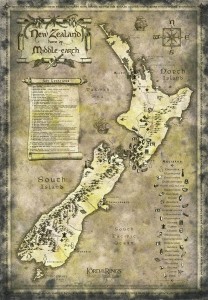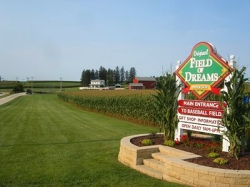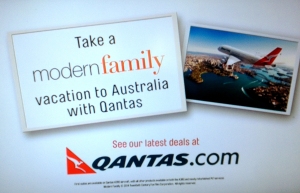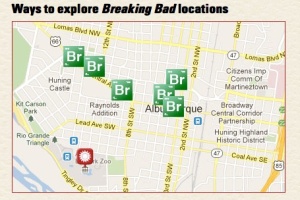If you really enjoyed Field of Dreams, you can step into the screen and play baseball with Shoeless Joe! If you thought the epic scope and fantastical world of The Lord of the Rings was super-awesome, you can ride to Rivendell with Aragorn and Frodo Baggins! If you miss having Tony Soprano in your living room every week, you can sit down in his! Well…sort of.
In real life, the Field of Dreams farm and baseball diamond is an Iowa tourist attraction that once saw 65,00 visitors a year, and the impact of LOTR tourism on the New Zealand economy has been estimated at US$27 million per year since the movies were released over ten years (!) ago. And of course, On Location Tours offers a 4-hour Sopranos Sites Tour, taking you through the magical land of New Jersey. Yup, this is the world of Film Tourism, where recreational travel and onscreen worlds combine; it seemed like an interesting topic to briefly delve into. (and yes, scholarly, it’s called “film” tourism even when related to TV shows)
Anthropologists have long been fascinated by tourism; we study it for a number of reasons: 1) it occurs in most, if not all, human societies – that is, most cultures have been touched by it in some way, by being visited if not being the visitors, 2) it has large economic impact around the world, and 3) it involves face-to-face encounters between people of different cultures; both sides get to see part of how the other people live.
And film tourism – travel to sites people have seen on TV and in movies – is big. In one British study, 10% of people surveyed said they had gone to visit a location or destination featured in a film, 6% said they had done so specifically because of seeing the film, and 13% said they were planning to go somewhere in the future, based on seeing it in a movie. In results attributed to the movie Frozen, the official Norwegian travel website (VisitNorway.com) witnessed its traffic nearly triple since the movie came out, and Flight Tracker reported a 153% increase in searches on Norwegian flights. A study by Riley, Baker, & Van Doren showed that after a movie is released, tourism to the sites in the film increases for four years.
TV- and film-influenced tourism has a variety of different expressions – it’s not necessarily just a visit to a waterfall seen in someone’s favorite TV show. A few examples showing the breadth of experience we’re talking about here:
- You can take part in the Chariots of Fire beach run: http://www.bbc.co.uk/news/uk-scotland-edinburgh-east-fife-18262315
- Follow the Albuquerque’s Convention & Visitor’s Bureau official Breaking Bad location map (http://www.visitalbuquerque.org/albuquerque/arts/breaking-bad/)
- Stay in a Frozen-themed suite at an ice hotel in Quebec, designed by the film’s production designer (http://ottawamommyclub.ca/disney-unveils-frozen-themed-suite-at-quebec-citys-ice-hotel%E2%80%8F/ )
When anthropologists study tourism, they ask what motivates tourists to travel, what distinguishes tourists from other travelers, and what kinds of places and experiences tourists seek. Of these, the most interesting question for us seems to be the first: what is it about a film or TV show that makes somebody want to visit the site where it was filmed, or where it takes place?
There is surely an element of wish-fulfillment; feeling like for at least a little while you live in the medieval fantasy world of the Game of Thrones’ Westeros, or are enjoying the same lifestyle as the vacationing upper-middle-class Dunphys of Modern Family. There is surely some element of pilgrimage, as well: making a trek to a space that is, in a media-saturated world, “sacred” in some ways. And for that matter, some of this tourism is based just on the beauty or draw of the place itself, but people may not have known about the location until its’ appearance onscreen: New Zealand was gorgeous long before Lord of the Rings ever shot there, but for many people, the movies were their first glimpse of the landscape in detail.

Lord of the Rings film locations, mapped onto the actual landscape of New Zealand: turning sight-seeing into site-seeing.
Film theorist Giuliana Bruno suggests that film spectatorship itself is a form of tourism (she calls it “site seeing” as well as “sight seeing” – cute). To some degree, what you’re doing is consuming a more constructed view of the real-world location; Middle Earth is a constructed form of New Zealand, the Field of Dreams farm (and field) a constructed form of Iowa. Think of it as having the same relation to reality that Main Street USA at Disneyland has to actual main streets.
One of the interesting things about the evolution of film tourism is the path from organic, populist movement to constructed commercial reality. That is to say, back when the Brady Brunch visited Hawaii in 1972, anyone who wanted to follow in their footsteps did so on their own; but by the time the Modern Family visited Australia, the tourist tie-in was planned far in advance of the air date, with an sponsorship agree between the network and Quantas. This isn’t bad, per se – if left to my own devices, I’d probably never find some of the cool places in Iceland where they film Game of Thrones. But it’s also inserted an element of the artificial and corporate into what is already a highly constructed media experience; in other words – you can go to Middle Earth these days, but you probably can’t do it with the Bradys.
(which may be good, since on vacations they seem to mess with evil idols)
— Scott Frank
- Aside from just the website search increases and the hotel suite in Quebec, Frozen is definitely the big winner this year, film-tourism wise. In addition to the figures noted above, Norwegian hotel bookings in the first 3 months of 2014 were up 37% from 2013, and tour operators are predicting summer business to up by 40%. In interviews, Harald Hansen, spokesperson for Visit Norway, credited the movie (as do many others).
- If you’re wondering about the economic impact of tourism, it’s huge: per the World bank, expenditures on tourism in 2012 were US$ 1,187,138,892,127 (roughly $1.1 trillion dollars). Some estiamtes say 2013 spending reached $1.4 trillion
- As a special bonus image, the official City of Albuquerque “Breaking Bad” visitor map:


